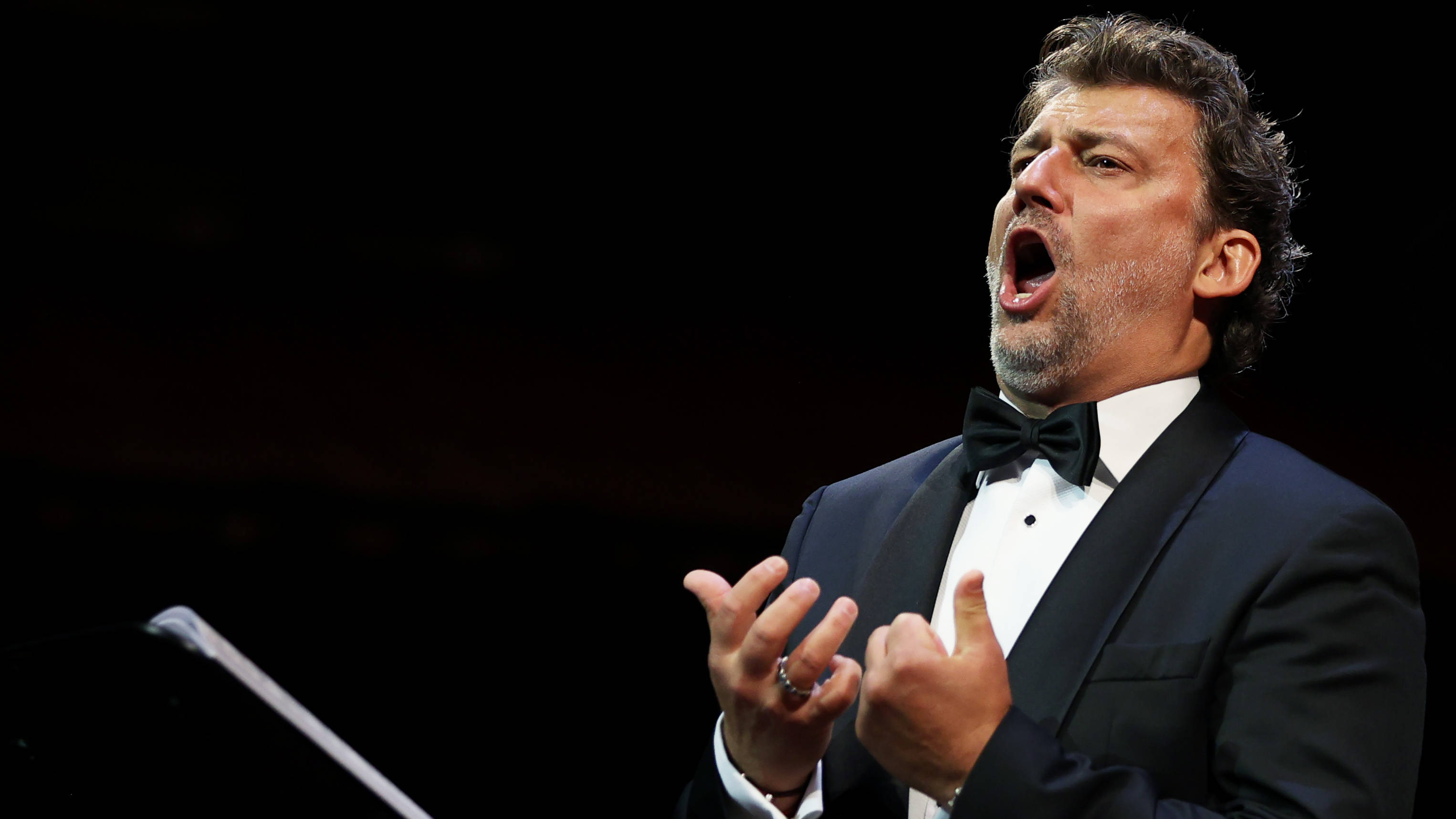Home>Production & Technology>Singer>What Is An Alto Singer


Singer
What Is An Alto Singer
Published: February 28, 2024
Learn about the unique qualities and range of an alto singer, and discover the role of this versatile vocalist in the world of music. Explore the characteristics and skills that define a talented singer.
(Many of the links in this article redirect to a specific reviewed product. Your purchase of these products through affiliate links helps to generate commission for AudioLover.com, at no extra cost. Learn more)
Table of Contents
Introduction
When it comes to the world of music, the human voice is an instrument like no other. It has the power to convey emotions, tell stories, and captivate audiences in a way that is truly unique. Within the realm of vocal performance, singers are often categorized based on their vocal range and tonal quality. One such classification is the alto singer.
The term "alto" originates from the Latin word "altus," which means "high." However, in the context of vocal music, an alto singer is not defined by singing high notes, but rather by their lower vocal range and rich, warm tonal quality. Alto singers play a crucial role in choral music, vocal ensembles, and various musical genres, adding depth and richness to the overall sound.
In this article, we will delve into the world of alto singers, exploring the defining characteristics of their vocal range, the role they play in music, and the notable figures who have left an indelible mark as alto singers. Whether you're an aspiring vocalist, a music enthusiast, or simply curious about the intricacies of vocal performance, this exploration of the alto singer's realm promises to be enlightening and engaging.
Definition of an Alto Singer
An alto singer, often referred to as a contralto in classical and choral music, is a vocal performer with a lower range than that of a soprano or mezzo-soprano. The alto range typically spans from the F below middle C to the second F above middle C, although individual vocal ranges may vary. What sets the alto voice apart is its distinct timbre, characterized by a warm, rich, and often darker tonal quality.
Alto singers are prized for their ability to add depth and resonance to vocal ensembles and choral arrangements. Their lower register provides a solid foundation for harmonies and lends a sense of fullness to the overall sound. In musical compositions, alto singers are often entrusted with melodies that require a more grounded and sonorous interpretation, complementing the higher voices in the ensemble.
It's important to note that the term "alto" can also refer to the vocal part written for an alto singer, regardless of the singer's gender. While traditionally, altos were predominantly female, there are instances in contemporary music where male vocalists with lower ranges, known as countertenors, may also perform alto parts.
In the realm of vocal classification, the alto singer occupies a vital role, contributing to the intricate tapestry of vocal music with their distinct tonal quality and expressive capabilities. Whether performing in a choir, as a soloist, or as part of a vocal ensemble, the alto singer's voice adds a layer of richness and emotional depth to the musical fabric, captivating audiences with its unique resonance and timbre.
Characteristics of an Alto Singer
At the core of an alto singer's identity are a set of distinctive characteristics that define their vocal prowess and artistic contribution. These traits, both physiological and expressive, shape the captivating allure of the alto voice and its role in the realm of vocal performance.
Rich and Warm Timbre
The hallmark of an alto singer lies in the rich, warm timbre that emanates from their vocal cords. This resonant quality imbues their performances with a depth and sonority that captivates listeners. Whether delivering soul-stirring ballads or harmonizing within a choral ensemble, the alto's timbre adds a layer of emotional richness to the musical narrative.
Lower Vocal Range
An alto singer's vocal range typically spans from the F below middle C to the second F above middle C, distinguishing them from the higher registers of sopranos and mezzo-sopranos. This lower range enables them to infuse compositions with a grounded, velvety quality, lending gravitas to the melodies they interpret and enhancing the harmonic structure of vocal arrangements.
Expressive Depth
Beyond the technical aspects of their vocal range, alto singers are celebrated for their expressive depth. Their ability to convey profound emotions through their lower register sets them apart as storytellers, capable of evoking poignant sentiments and infusing compositions with a sense of introspection and resonance.
Resonance and Fullness
The alto voice possesses a natural resonance and fullness that elevates the tonal palette of any musical ensemble. Whether performing as part of a choir, a vocal quartet, or as a soloist, the alto singer's voice serves as a foundational pillar, infusing the music with a sense of depth and completeness.
Versatility and Adaptability
Alto singers exhibit remarkable versatility, seamlessly transitioning between various musical genres and vocal styles. Whether interpreting classical arias, delivering jazz standards, or lending their voice to contemporary pop ballads, alto singers bring a versatile and adaptable quality to their performances, enriching the musical landscape with their diverse repertoire.
In essence, the characteristics of an alto singer encapsulate a fusion of technical prowess, emotional depth, and sonic allure. Their vocal timbre, expressive range, and adaptability converge to form a captivating mosaic that resonates with audiences and enriches the fabric of vocal music. As we explore the world of alto singers, these defining characteristics serve as a testament to the enduring appeal and artistic significance of the alto voice in the realm of vocal performance.
Range of an Alto Singer
The vocal range of an alto singer is a defining aspect of their artistic identity, encompassing a span of notes that showcases the lower register of the human voice. Typically, an alto singer's range extends from the F below middle C to the second F above middle C, although individual variations may occur. This lower range distinguishes the alto voice from the higher registers of sopranos and mezzo-sopranos, positioning it as a foundational element in vocal ensembles and choral compositions.
At the lower end of their range, alto singers possess a depth and richness that infuses compositions with a sense of gravitas and emotional resonance. The lower notes resonate with a warm, velvety timbre, adding a layer of depth to the overall vocal texture. This lower register allows alto singers to provide a solid foundation for harmonies, anchoring the vocal arrangements with a sense of stability and fullness.
As the alto range ascends, the voice maintains its characteristic richness and timbral warmth, offering a seamless transition into the mid-range. This versatility enables alto singers to navigate a diverse repertoire of musical genres, from classical and choral works to jazz, blues, and contemporary pop. Whether delivering soulful ballads or contributing to intricate vocal harmonies, the alto range encompasses a spectrum of expressive possibilities, allowing singers to convey a wide range of emotions and musical narratives.
In the upper portion of their range, alto singers demonstrate a controlled and resonant quality, infusing compositions with a sense of clarity and depth. While not reaching the soaring heights of sopranos, the upper notes of the alto range possess a distinct allure, adding a touch of luminosity to vocal arrangements and solo performances.
The range of an alto singer, spanning from the lower depths to the resonant highs, embodies a captivating spectrum of tonal colors and expressive capabilities. It serves as a testament to the versatility and depth of the alto voice, showcasing its ability to enrich musical compositions with a profound sense of emotional depth and sonic allure. As a foundational element in vocal ensembles and a compelling solo voice, the range of an alto singer stands as a testament to the enduring appeal and artistic significance of the alto voice in the realm of vocal performance.
Role of an Alto Singer in Music
The role of an alto singer in music is multifaceted and indispensable, encompassing a diverse array of contributions that enrich vocal ensembles, choral compositions, and solo performances. At the heart of this role lies the unique tonal quality and expressive depth of the alto voice, which imbues musical arrangements with a sense of resonance, emotional richness, and harmonic completeness.
In choral music, alto singers serve as a foundational pillar, providing a crucial underpinning for vocal harmonies and adding depth to the overall sonic tapestry. Their lower register infuses compositions with a sense of gravitas and warmth, creating a balanced and immersive vocal landscape. Whether interpreting classical masterpieces, sacred choral works, or contemporary arrangements, alto singers play a pivotal role in shaping the harmonic structure and emotional resonance of choral performances.
Within vocal ensembles, the alto voice assumes a versatile and adaptive role, seamlessly blending with other vocal parts to create a harmonious fusion of timbres and textures. Alto singers contribute to the intricate interplay of vocal lines, adding a layer of depth and richness that elevates the ensemble's collective sound. Their ability to navigate a diverse repertoire of musical genres, from classical to contemporary, underscores the versatility and adaptability of the alto voice, making it an indispensable component of vocal ensemble performances.
As soloists, alto singers bring a distinctive allure to their interpretations, infusing compositions with a sense of introspection, emotional depth, and sonic allure. Their expressive range and resonant timbre enable them to convey a wide spectrum of emotions, from melancholic introspection to exuberant passion, captivating audiences with their evocative storytelling and vocal artistry.
Moreover, the role of an alto singer extends beyond traditional choral and vocal ensemble settings, permeating diverse musical genres such as jazz, blues, gospel, and pop. In each of these genres, the alto voice adds a layer of soulful allure, contributing to the expressive palette of the musical landscape and enriching compositions with its distinctive tonal quality and emotive resonance.
In essence, the role of an alto singer in music is defined by its ability to infuse compositions with a sense of depth, emotional resonance, and harmonic completeness. Whether as part of a choral ensemble, a vocal quartet, or as a solo performer, the alto voice stands as a testament to the enduring allure and artistic significance of vocal music, captivating audiences with its rich timbre, expressive depth, and indispensable role in the realm of musical performance.
Famous Alto Singers
The world of music has been graced by the remarkable artistry of numerous renowned alto singers, whose distinctive voices and captivating performances have left an indelible mark on the realm of vocal music. These iconic figures have not only showcased the captivating allure of the alto voice but have also contributed to the rich tapestry of musical expression across diverse genres and eras. Let's explore the lives and contributions of some of the most celebrated alto singers in the history of music.
Marian Anderson
Marian Anderson, an American contralto, rose to international prominence as a trailblazing African American classical singer. Her velvety voice and profound artistry captivated audiences worldwide, transcending racial barriers and paving the way for future generations of vocalists. Anderson's historic performance at the Lincoln Memorial in 1939, after being denied a concert at a segregated venue, stands as a testament to her resilience and the transformative power of her art.
Kathleen Ferrier
Kathleen Ferrier, a British contralto, garnered acclaim for her emotive interpretations of classical and folk repertoire. Her rich, expressive voice and poignant delivery made her a beloved figure in the world of opera and art song. Ferrier's renditions of Gustav Mahler's compositions, in particular, showcased her ability to convey profound emotions through her resonant and evocative voice, solidifying her legacy as a true master of the alto art.
Jessye Norman
Jessye Norman, an American soprano with a distinctive mezzo-soprano range, transcended vocal categorizations with her commanding stage presence and sumptuous vocal timbre. While often associated with soprano roles, Norman's lower register possessed the depth and richness characteristic of alto voices, allowing her to captivate audiences with her unparalleled artistry. Her renditions of spirituals and operatic arias showcased the captivating allure of her lower vocal range, cementing her status as a vocal luminary.
Shirley Verrett
Shirley Verrett, an American mezzo-soprano, possessed a vocal range that seamlessly traversed the realms of mezzo-soprano and contralto, making her a versatile and compelling interpreter of diverse repertoire. Her performances in operatic roles, ranging from the dramatic to the lyric, showcased the breadth and depth of her vocal artistry. Verrett's ability to infuse her interpretations with emotional depth and sonic allure solidified her reputation as a consummate artist of the alto realm.
Cecilia Bartoli
Cecilia Bartoli, an Italian mezzo-soprano, has enraptured audiences with her dazzling coloratura and expressive depth, establishing herself as a leading figure in the world of classical vocal performance. Bartoli's vocal agility and emotive delivery have brought new dimensions to the interpretation of Baroque and bel canto repertoire, showcasing the versatility and allure of the mezzo-soprano voice in the realm of classical music.
These iconic alto singers, through their unparalleled artistry and captivating voices, have left an indelible legacy in the annals of vocal music. Their contributions have not only elevated the status of the alto voice but have also enriched the world of music with a profound sense of emotional depth, sonic allure, and artistic significance. As their timeless recordings and enduring influence continue to inspire generations of vocalists, the legacy of these famous alto singers remains a testament to the enduring allure and artistic significance of the alto voice in the realm of vocal performance.











